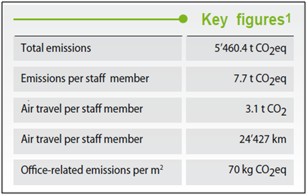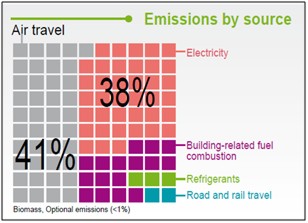Climate Change : Climate Neutral Initiative
The UN Climate Neutral Strategy committs all UN agencies, programmes and funds to achieve the following three goals:
- Estimate the annual greenhouse gas emissions, consistent with accepted international standards.
- Undertake efforts to reduce greenhouse gas emissions.
- Analyze the cost implications and explore budgetary modalities of purchasing carbon offsets to eventually reach climate neutrality.
Although the implementation of the Climate Neutral UN initiative is the responsibility of each UN organization, the Environment Management Group, chaired by UNEP, was tasked to oversee, coordinate and report on the implementation of this collective effort. The Environment Management Group presented the first results during a side event to COP15 and published them in the report “Moving Towards a Climate Neutral UN”.
In 2009 the UN system quantified its greenhouse gas emissions for the first time. The inventory was prepared by using UNEP’s Greenhouse Gas Calculator for those emissions arising from facilities, operations, non-air travel, and ICAO’s Carbon Emissions Calculator for the aviation related emissions.
 |
 |
|---|
Figure 1: ICAO`s total emissions and key greenhouse performance indicators.
Inventory results showed that ICAO’s climate footprint for the 2008 baseline year was approximately 5,500 metric tons of carbon dioxide equivalents. The two largest contributors to this total were emissions due to air travel (41%) and emissions from purchased electricity (38%).
These results were aggregated within the GHG inventory of the UN system organizations for their facility operations, travel, and peacekeeping operations: in 2008 greenhouse gas emissions from UN were estimated at just over 1.7 million tons of CO2 equivalents. When excluding peacekeeping operations, the emissions were approximately 770,000 tons of CO2 equivalents. 6. As air travel is responsible for nearly half of the total UN emissions, the improvement of the ICAO Carbon Emissions Calculator and the continued cooperation with UN family organizations is of paramount importance for the success of the Climate Neutral UN initiative.
In terms of emissions reductions, there has been much progress in recent years in greening ICAO. A major milestone was the achievement of Canada’s first LEED-EB (Leadership in Energy and Environmental Design for Existing Buildings) Gold Certification that was awarded to ICAO Headquarters in Montréal. The ICAO Headquarters building required major work in order to meet LEED standards, which involved significant challenges as several modifications had to be made in terms of lighting, plumbing, ventilation, water use, recycling, and maintenance.
The achievement of this certification by the company that owns and leases the Organization`s Headquarters underscores ICAO’s desire to integrate environmental considerations into its daily operations and building management.
Even before the CNUN initiative was launched, the ICAO Secretariat had implemented a series of environmentally-friendly practices such as: conducting paperless meetings, more audio and video, and using web-meeting services; as well as many other initiatives aimed to reduce energy consumption. The challenge for the next few years is to formalize the isolated environmental initiatives into cohesive policies and staff regulations. As part of this effort, UN organizations agreed to prepare their first Emission Reduction Plan, to achieve further emission reductions to be monitored against the inventory data already collected.